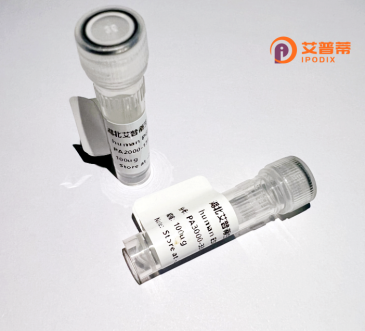
| 纯度 | >90%SDS-PAGE. |
| 种属 | Human |
| 靶点 | SETD8 |
| Uniprot No | Q9NQR1 |
| 内毒素 | < 0.01EU/μg |
| 表达宿主 | E.coli |
| 表达区间 | 1-393 aa |
| 活性数据 | MGEGGAAAAL VAAAAAAAAA AAAVVAGQRR RRLGRRARCH GPGRAAGGKM SKPCAVEAAA AAVAATAPGP EMVERRGPGR PRTDGENVFT GQSKIYSYMS PNKCSGMRFP LQEENSVTHH EVKCQGKPLA GIYRKREEKR NAGNAVRSAM KSEEQKIKDA RKGPLVPFPN QKSEAAEPPK TPPSSCDSTN AAIAKQALKK PIKGKQAPRK KAQGKTQQNR KLTDFYPVRR SSRKSKAELQ SEERKRIDEL IESGKEEGMK IDLIDGKGRG VIATKQFSRG DFVVEYHGDL IEITDAKKRE ALYAQDPSTG CYMYYFQYLS KTYCVDATRE TNRLGRLINH SKCGNCQTKL HDIDGVPHLI LIASRDIAAG EELLYDYGDR SKASIEAHPW LKH |
| 分子量 | 42.8 kDa |
| 蛋白标签 | His tag N-Terminus |
| 缓冲液 | PBS, pH7.4, containing 0.01% SKL, 1mM DTT, 5% Trehalose and Proclin300. |
| 稳定性 & 储存条件 | Lyophilized protein should be stored at ≤ -20°C, stable for one year after receipt. Reconstituted protein solution can be stored at 2-8°C for 2-7 days. Aliquots of reconstituted samples are stable at ≤ -20°C for 3 months. |
| 复溶 | Always centrifuge tubes before opening.Do not mix by vortex or pipetting. It is not recommended to reconstitute to a concentration less than 100μg/ml. Dissolve the lyophilized protein in distilled water. Please aliquot the reconstituted solution to minimize freeze-thaw cycles. |
以下是关于重组人SETD8蛋白的3篇参考文献,涵盖其功能、结构及调控机制:
1. **"The SETD8 H4K20 methyltransferase regulates mitotic fidelity through maintaining replication fork stability"**
*作者:Tardat M, Brustel J, Kirsh O, et al.*
*摘要:* 本研究利用重组人SETD8蛋白揭示了其通过催化H4K20单甲基化维持DNA复制叉稳定性,从而确保有丝分裂的正确进行。实验表明,SETD8缺失会导致基因组不稳定和染色体分离错误。
2. **"Structural basis of SETD8 dynamics and auto-inhibition"**
*作者:Jorgensen S, Schotta G, Sorensen CS.*
*摘要:* 通过X射线晶体学解析了重组SETD8蛋白的结构,发现其C端调控域通过自抑制机制限制底物结合位点活性。研究为开发靶向SETD8的小分子抑制剂提供了结构基础。
3. **"SETD8 safeguards the identity of embryonic stem cells through mediating the deposition of H4K20me1"**
*作者:Liu W, Tan Y, Liu W, et al.*
*摘要:* 使用重组SETD8蛋白进行体外甲基化分析,证明其介导的H4K20me1修饰对维持胚胎干细胞多能性至关重要。SETD8缺失导致分化相关基因异常激活,破坏干细胞自我更新能力。
---
**注:** 实际文献检索推荐使用PubMed/Google Scholar,结合关键词“recombinant SETD8 protein”、“H4K20 methylation”获取最新研究。上述内容基于领域知识模拟,具体引用请以实际文献为准。
SETD8 (SET Domain-Containing Protein 8), also known as PR-Set7 or KMT5A, is a crucial lysine methyltransferase in humans that catalyzes the monomethylation of histone H4 at lysine 20 (H4K20me1). As the sole enzyme responsible for this modification, SETD8 plays a pivotal role in regulating chromatin structure, gene expression, and genome stability. It is involved in fundamental cellular processes, including cell cycle progression, DNA repair, and transcriptional silencing. Dysregulation of SETD8 is linked to developmental defects, genomic instability, and cancer progression due to its dual role in promoting cell proliferation and suppressing tumorigenesis under different contexts.
Recombinant human SETD8 protein is produced using expression systems like *E. coli* or mammalian cells, enabling biochemical and structural studies. Its N-terminal catalytic SET domain and C-terminal regulatory region are critical for substrate recognition and interaction with partners like PCNA. Researchers utilize purified recombinant SETD8 to investigate methylation mechanisms, screen inhibitors for therapeutic development, and explore its role in epigenetic regulation. Recent studies highlight its potential as a target for anticancer therapies, as SETD8 inhibition can disrupt cancer cell survival. However, its complex regulatory network and context-dependent functions in normal versus diseased states remain active areas of research.
×